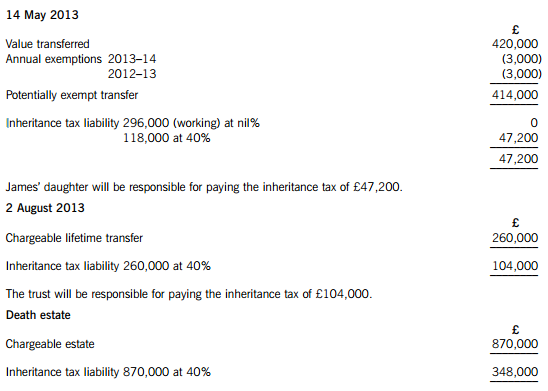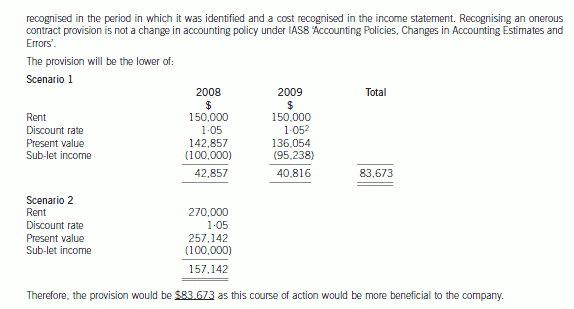2019年上海ACCA报名条件
发布时间:2019-01-06
2019年上海ACCA报名条件:
a.具有教育部认可的大专以上学历,既可以报名成为ACCA的正式学员。
b.教育部认可的高等院校在校生,且顺利通过第一学年的所有课程考试,既可报名成为ACCA正式学员。
c.未符合以上报名资格的申请者,而年龄在21岁以上,可以遵循成年考生(MSER)途径申请入会。该途径允许学生作为ACCA校外进修生学习,只须在前两年的四次考试中通过1.1和1.2两门课程,便能以正式学员身份继续参加其它课程考试。
下面小编为大家准备了 ACCA考试 的相关考题,供大家学习参考。
James died on 22 January 2015. He had made the following gifts during his lifetime:
(1) On 9 October 2007, a cash gift of £35,000 to a trust. No lifetime inheritance tax was payable in respect of this gift.
(2) On 14 May 2013, a cash gift of £420,000 to his daughter.
(3) On 2 August 2013, a gift of a property valued at £260,000 to a trust. No lifetime inheritance tax was payable in respect of this gift because it was covered by the nil rate band. By the time of James’ death on 22 January 2015, the property had increased in value to £310,000.
On 22 January 2015, James’ estate was valued at £870,000. Under the terms of his will, James left his entire estate to his children.
The nil rate band of James’ wife was fully utilised when she died ten years ago.
The nil rate band for the tax year 2007–08 is £300,000, and for the tax year 2013–14 it is £325,000.
Required:
(a) Calculate the inheritance tax which will be payable as a result of James’ death, and state who will be responsible for paying the tax. (6 marks)
(b) Explain why it might have been beneficial for inheritance tax purposes if James had left a portion of his estate to his grandchildren rather than to his children. (2 marks)
(c) Explain why it might be advantageous for inheritance tax purposes for a person to make lifetime gifts even when such gifts are made within seven years of death.
Notes:
1. Your answer should include a calculation of James’ inheritance tax saving from making the gift of property to the trust on 2 August 2013 rather than retaining the property until his death.
2. You are not expected to consider lifetime exemptions in this part of the question. (2 marks)
(a) James – Inheritance tax arising on death
Lifetime transfers within seven years of death

The personal representatives of James’ estate will be responsible for paying the inheritance tax of £348,000.
Working – Available nil rate band

(b) Skipping a generation avoids a further charge to inheritance tax when the children die. Gifts will then only be taxed once before being inherited by the grandchildren, rather than twice.
(c) (1) Even if the donor does not survive for seven years, taper relief will reduce the amount of IHT payable after three years.
(2) The value of potentially exempt transfers and chargeable lifetime transfers are fixed at the time they are made.
(3) James therefore saved inheritance tax of £20,000 ((310,000 – 260,000) at 40%) by making the lifetime gift of property.
(b) Discuss the nature of the following issues in developing IFRSs for SMEs.
(i) The purpose of the standards and the type of entity to whom they should apply. (7 marks)
(b) There are several issues which need to be addressed when developing IFRSs for SMEs:
(i) The purpose of the standards and type of entity
The principal aim of the development of an accounting framework for SMEs is to provide a framework which generates
relevant, reliable and useful information. The standards should provide high quality and understandable accounting
standards suitable for SMEs globally. Additionally they should meet the needs set out in (a) above. For example reduce
the financial reporting burden for SMEs. It is unlikely that one of the objectives would be to provide information for
management or meet the needs of the tax authorities as these bodies will have specific requirements which would be
difficult to meet in an accounting standard. However, it is likely that the standards for SMEs will be a modified version
of the full IFRSs and not an independently developed set of standards in order that they are based on the same
conceptual framework and will allow easier transition to full IFRS if the SME grows or decides to become a publicly listed
entity.
It is important to define the type of entity for which the standards are intended. Companies who have issued shares to
the public would be expected to use full IFRS. The question arises as to whether SME standards should apply to all
unlisted entities or just those listed entities below a certain size threshold. The difficulty with size criteria is that it would
have to apply worldwide and it would be very difficult to specify such criteria. Additionally some unlisted companies, for
example public utilities, have a reporting obligation that is equivalent to that of a listed company and should follow full
IFRS.
The main characteristic which distinguishes SMEs from other entities is the degree of public accountability. Thus the
definition of what constitutes an SME could revolve around those entities that do not have public accountability.
Indicators of public accountability will have to be developed. For example, a listed company or companies holding assets
in a fiduciary capacity (bank), or a public utility, or an entity with economic significance in its country. Thus all entities
that do not have public accountability may be considered as potential users of IFRSs for SMEs.
Size may not be the best way to determine what is an SME. SMEs could be defined by reference to ownership and themanagement of the entity. SMEs are not necessarily just smaller versions of public companies.
(d) Wader has decided to close one of its overseas branches. A board meeting was held on 30 April 2007 when a
detailed formal plan was presented to the board. The plan was formalised and accepted at that meeting. Letters
were sent out to customers, suppliers and workers on 15 May 2007 and meetings were held prior to the year
end to determine the issues involved in the closure. The plan is to be implemented in June 2007. The company
wish to provide $8 million for the restructuring but are unsure as to whether this is permissible. Additionally there
was an issue raised at one of the meetings. The operations of the branch are to be moved to another country
from June 2007 but the operating lease on the present buildings of the branch is non-cancellable and runs for
another two years, until 31 May 2009. The annual rent of the buildings is $150,000 payable in arrears on
31 May and the lessor has offered to take a single payment of $270,000 on 31 May 2008 to settle the
outstanding amount owing and terminate the lease on that date. Wader has additionally obtained permission to
sublet the building at a rental of $100,000 per year, payable in advance on 1 June. The company needs advice
on how to treat the above under IAS37 ‘Provisions, Contingent Liabilities and Contingent Assets’. (7 marks)
Required:
Discuss the accounting treatments of the above items in the financial statements for the year ended 31 May
2007.
Note: a discount rate of 5% should be used where necessary. Candidates should show suitable calculations where
necessary.
(d) A provision under IAS37 ‘Provisions, Contingent Liabilities and Contingent assets’ can only be made in relation to the entity’s
restructuring plans where there is both a detailed formal plan in place and the plans have been announced to those affected.
The plan should identify areas of the business affected, the impact on employees and the likely cost of the restructuring and
the timescale for implementation. There should be a short timescale between communicating the plan and starting to
implement it. A provision should not be recognised until a plan is formalised.
A decision to restructure before the balance sheet date is not sufficient in itself for a provision to be recognised. A formal plan
should be announced prior to the balance sheet date. A constructive obligation should have arisen. It arises where there has
been a detailed formal plan and this has raised a valid expectation in the minds of those affected. The provision should only
include direct expenditure arising from the restructuring. Such amounts do not include costs associated with ongoing business
operations. Costs of retraining staff or relocating continuing staff or marketing or investment in new systems and distribution
networks, are excluded. It seems as though in this case a constructive obligation has arisen as there have been detailed formal
plans approved and communicated thus raising valid expectations. The provision can be allowed subject to the exclusion of
the costs outlined above.
Although executory contracts are outside IAS37, it is permissible to recognise a provision that is onerous. Onerous contracts
can result from restructuring plans or on a stand alone basis. A provision should be made for the best estimate of the excess
unavoidable costs under the onerous contract. This estimate should assess any likely level of future income from new sources.
Thus in this case, the rental income from sub-letting the building should be taken into account. The provision should be

声明:本文内容由互联网用户自发贡献自行上传,本网站不拥有所有权,未作人工编辑处理,也不承担相关法律责任。如果您发现有涉嫌版权的内容,欢迎发送邮件至:contact@51tk.com 进行举报,并提供相关证据,工作人员会在5个工作日内联系你,一经查实,本站将立刻删除涉嫌侵权内容。
- 2020-02-26
- 2020-01-10
- 2020-02-22
- 2020-01-07
- 2019-12-27
- 2020-02-22
- 2020-02-26
- 2020-01-10
- 2020-02-26
- 2019-01-06
- 2020-01-04
- 2020-01-09
- 2020-01-10
- 2020-01-10
- 2020-01-10
- 2020-01-10
- 2020-01-10
- 2020-01-03
- 2020-02-26
- 2020-01-10
- 2020-02-23
- 2020-02-26
- 2020-01-03
- 2020-01-03
- 2019-01-06
- 2020-01-09
- 2020-01-09
- 2020-02-28
- 2020-01-09
- 2020-01-03